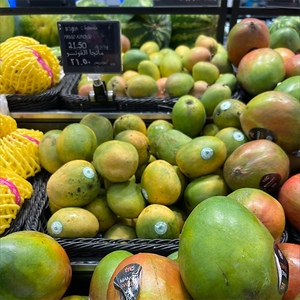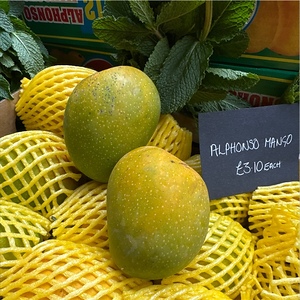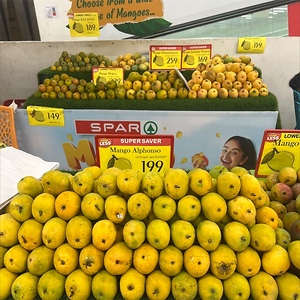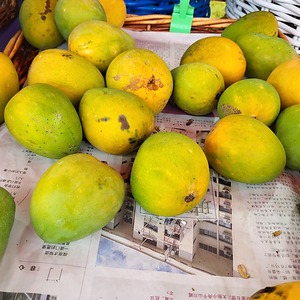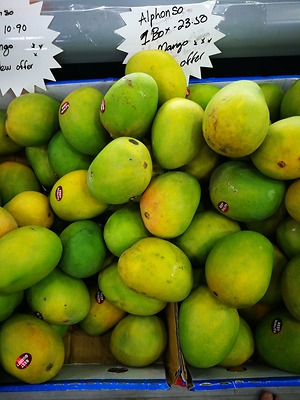

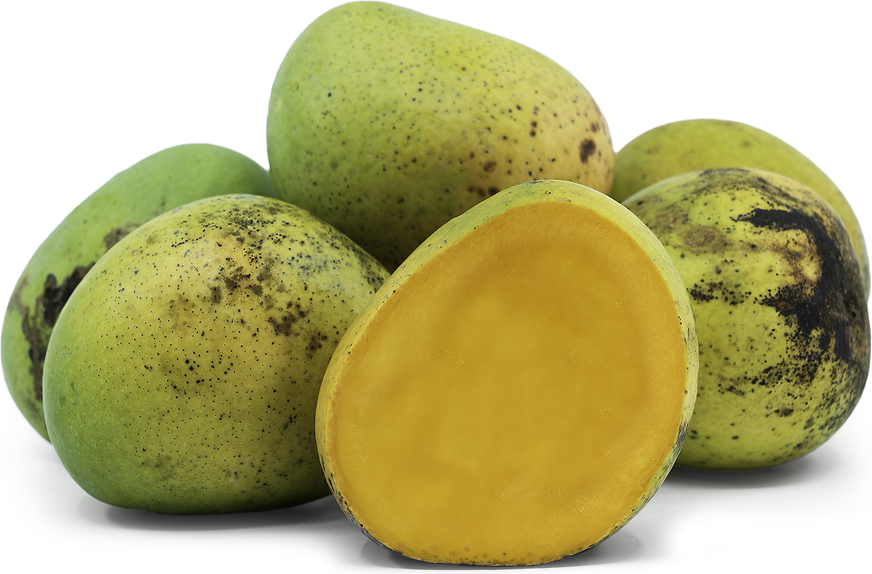
Alphonso Mangoes
Estimated Inventory, ea : 0
Description/Taste
Alphonso mangoes vary in size and appearance, depending on their growing region, and average 10 to 15 centimeters in length and 150 to 300 grams in weight. The fruits typically have an oval to oblong shape with blunt, curved ends, and the skin is thin but resilient, able to withstand transport. Alphonso mangoes ripen from green to shades of golden yellow and are sometimes tinged with red blush. Black or brown spots and markings may also occur on the surface, but these are mostly superficial and don’t affect the quality of the flesh. Underneath the skin, the orange flesh is dense, smooth, aqueous, and fibreless, with a buttery, tender, and succulent consistency. The flesh also encases a small, oval-shaped seed. Alphonso mangoes emit a permeating, fragrant aroma when ripe, said to smell musky, floral, and sweet. Select Alphonso mangoes that are ripe, soft to the touch, and still have smooth skin. Alphonso mango skin remains taut, unlike other varieties that may wrinkle with maturity. Alphonso mangoes are edible raw when ripe and have a high sugar content, creating a rich, sweet, fruity, and spiced-filled flavor with subtle honey, melon, stone-fruit, and tropical nuances.
Seasons/Availability
Alphonso mangoes are available for a limited season in India, typically from March to June. In Florida, the fruits are harvested from late June through July.
Current Facts
Alphonso mangoes, botanically classified as Mangifera indica, are an Indian variety belonging to the Anacardiaceae family. The variety arose from cross-pollination and selective breeding in the 16th century and became known for its smooth, tender, and juicy flesh and rich, sweet taste. Alphonso mangoes are synonymous with the summer season in India and are an anticipated seasonal fruit eaten as a refreshing reprieve. It is important to note that many types of Alphonso mangoes are found in regions throughout India. Each area is thought to have a unique climate that gives the mangoes a slightly different flavor. It is common for Alphonso mangoes to be sold with their growing region in their names, and in India, the variety is also known as Hapus, Hafoos, and Hapoos. Outside of India, Alphonso mangoes have become a favored variety worldwide. Despite their popularity, Alphonso mangoes are notoriously challenging to cultivate. The variety is labor-intensive and must be monitored during grafting, pruning, and cultivation. The fruits must also be hand-harvested to protect their delicate skin. When in season, Alphonso mangoes are primarily eaten fresh but are also incorporated into a wide array of sweet or savory preparations.
Nutritional Value
Alphonso mangoes are a source of fiber to regulate the digestive, vitamin C to strengthen the immune system, magnesium to control nerve functions, and potassium to balance fluid levels within the body. Mangoes also provide calcium to protect bones and teeth, iron to develop the protein hemoglobin for oxygen transport through the bloodstream, phosphorus to repair tissues, vitamin E to guard the cells against the damage caused by free radicals, and other nutrients, including vitamin K, copper, manganese, zinc, vitamin A, riboflavin, niacin, and thiamine.
Applications
Alphonso mangoes have a sweet, tropical, and spice-filled flavor suited for fresh and cooked preparations. In India, Alphonso mangoes are only available for a limited time each year, and due to their premium nature, the mangoes are traditionally sliced and served fresh. Alphonso mangoes are sold in local markets throughout India, sliced by vendors, and sprinkled with chili powder as an on-the-go snack. The variety is sometimes included in refreshing beverages such as lassi, shakes, or smoothies. Alphonso mangoes are also cooked into chutneys, salsas, sauces, and purees. The fruit’s soft, sweet flesh complements rice dishes, dals, and achars, or it can be added to kesari, which is a sweet pudding. Alphonso mangoes are occasionally used in kalakand, an Indian sweet, mango moramda, a preserve, or kulfi, a frozen dairy dessert. The fruits also provide flavoring to ice creams, sorbets, pies, cakes, mousses, or sauces for dipping fritters. Try drying the fruits into strips for extended use. Outside of India, Alphonso mangoes can be utilized in any preparation, calling for ripe mangoes. Alphonso mangoes pair well with maple syrup, honey, brown sugar, other fruits, including raspberries, bananas, and apricots, and spices such as cinnamon, nutmeg, and cloves. Whole, unwashed Alphonso mangoes should be ripened at room temperature away from direct sunlight. Once ripe, the fruits are recommended to be immediately consumed for the best quality and flavor. They can also be stored for a day or two in the refrigerator.
Ethnic/Cultural Info
There are several theories as to how Alphonso mangoes acquired their name. The most prevalent theory claims that the fruits are named after Afonso de Albuquerque, the Portuguese viceroy and general who established a colony in Goa in 1510. Albuquerque used Goa to establish a Portuguese stronghold in India and later became known as the Duke of Goa. He also became famous for contributing to a portion of the Columbian exchange between South America and India, introducing crops from the New World into India. At one time, it was rumored that mangoes were sent through this chain from India to the New World and parts of Africa. While this theory is widely known, most experts believe the most likely theory connects the variety to Jesuit missionary Nicolau Alfonso, a horticulturist who grafted mangoes in India in the mid-16th century. The Portuguese desired to create a mango variety that could be exported to Europe. Jesuit missionaries implemented grafting techniques to develop new varieties and traditionally named the new fruits after themselves, political leaders, or other Portuguese names. The final theory hypothesizes that Jesuit missionaries may have named the variety after Jesuit Saint Alphonso Rodriquez of Spain.
Geography/History
Alphonso mangoes are native to India and were developed in the 16th century by Jesuit missionaries in the Konkan region along the Western coast. Mangoes have been grown throughout India since ancient times, and historically, soft pulpy varieties were preferred as the flesh could be sucked from the fruits. In the 16th century, the Portuguese arrived in India and colonized the state of Goa. After their arrival, Jesuit missionaries also settled in and around the colony in nearby districts and began breeding and grafting mangoes in 1550. The priests desired to create a mango variety that could withstand shipping, allowing them to export the fruits worldwide. The exact origins of where Alphonso mangoes first arose are unknown, but some experts hypothesize that they may have been developed through cross-pollination between Indian mangoes and graftings gathered from Southeast Asia in the town of Vengurla within the Sindhudurg district just north of Goa. Alphonso mangoes were recorded in written documents by 1563, and the variety thrived in the region's warm and humid climate. Over time, Alphonso mangoes spread in cultivation along the western coast of India and became established in several areas of the Konkan region. Each region had varying soils, climate, and water availability, creating a unique microclimate for Alphonso mangoes to vary slightly in flavor, texture, and appearance. Today, Alphonso mangoes grown in India are often labeled by their growing region, such as Ratnagiri Alphonso mangoes, Devgad Alphonso mangoes, and Karwar Alphonso mangoes. Ratnagiri Alphonso mangoes are typically regarded as the premium regional variety and are often sold at the highest prices. In the late 20th century, Alphonso mangoes were gifted from Crawford Market of Mumbai in 1953 to England as part of Queen Elizabeth’s coronation in London. Since this gift, the variety has been annually imported from India into England. Alphonso mangoes have also been introduced to select growing regions worldwide for commercial production. In the United States, the variety was planted in Florida and California and is grown on a small scale as a specialty mango. Alphonso mangoes are also exported worldwide from India as a seasonal fruit and are sent to countries in Asia, Europe, the Middle East, Australia, and North America. When in season, Alphonso mangoes are sold through select distributors and grocers.
Recipe Ideas
Recipes that include Alphonso Mangoes. One
| Veg Recipes of India |
|
Aamras Recipe (Sweet Mango Pulp) |
| Cubes N Juliennes |
|
Indian Mango Rice Pudding |
Podcasts



